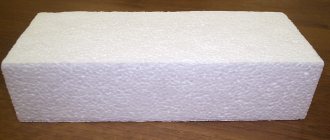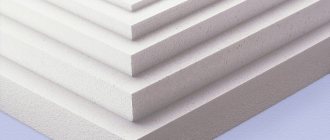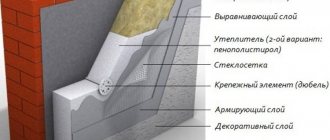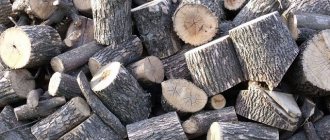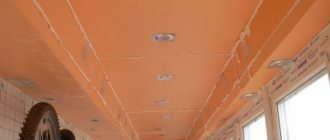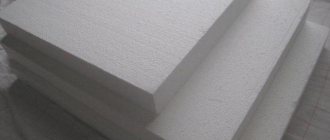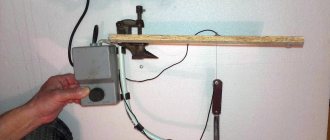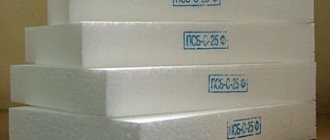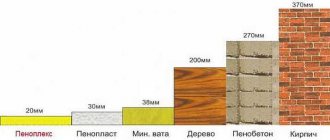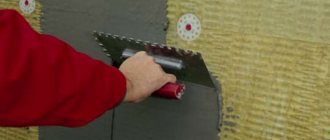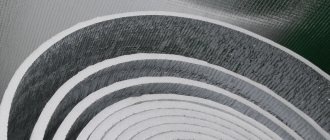Production
These two materials are completely synthetic, but they are produced using different technologies. To produce polystyrene foam, a polystyrene or formaldehyde base is used. Substances are added to it that form foam.
These substances use air to create foam. As a result, a huge number of bubbles are formed, filled with a synthetic base. The entire process takes place under normal conditions without elevated temperatures or pressure.
After the reaction is complete, small polystyrene or formaldehyde balls remain. To make polystyrene foam, elements with a diameter of 3–5 mm are selected and pressed. The result is slabs of different thicknesses from 1–2 cm to 10 or more.
As for penoplex, it is made from ready-made polystyrene balls. The finished mass is loaded into a high-pressure oven called an extruder. Everything melts there, decreases in size and floats onto the prepared base. The result is a slab that is slightly thinner than foam would otherwise be.
Characteristics of foam plastic
This material is 98% air and only 2% is polystyrene itself. As everyone knows, air is the worst conductor of heat, so it has excellent thermal insulation characteristics.
It is used to insulate almost all parts of the house, with the exception of the floor. What are the advantages of using this material:
- Absolutely does not absorb moisture.
- Microorganisms do not live on synthetic surfaces.
- Poorly supports the combustion process.
- Very light.
- Cheap.
- You can insulate houses from different materials.
- Long service life.
- Absorbs sound well (noise insulator).
- Easy to install.
Despite so many positive aspects, there are also several significant disadvantages. Pressed polystyrene foam practically does not allow moisture to pass through. This disadvantage should not be neglected if the house is made of wood or other breathable material. Moisture will accumulate between the insulation and the wall, causing rot.
If this material is chosen for insulating the facade of such a house, then you should additionally use forced ventilation or install a ventilated facade.
In addition, although the material does not support combustion, under the influence of high temperature it releases toxic substances into the environment. In order for foam insulation to last as long as possible, it must be protected from sunlight.
Otherwise, the slab will fall apart into a huge number of small balls. Without a good protective coating, it is easily broken or pierced. I most often lay polystyrene foam under plaster or siding. This material is contraindicated to be coated with paint. He is very afraid of solvents.
What is the difference between polystyrene foam and polystyrene foam?
Both materials have a lot in common. Considering that polystyrene foam is essentially the same polystyrene foam, however, they have significant differences due to their production technology. Let's first consider the positive and negative properties of polystyrene foam. The positive characteristics of this material include:
- Low cost of finished products, which is one and a half times lower than the price of extrusion material.
- Long service life subject to installation and operating conditions.
- High degree of thermal insulation with proper installation and further operation. Light weight, which facilitates transportation and installation.
- In the structure of the material, if it is used in dry conditions, fungi, mold and other microorganisms do not develop.
- It is easy to process (cut, saw, break) with any available tools and even by hand. It does not require the worker to be provided with protective equipment, since it is an environmentally safe material - it does not emit harmful odors and dust, and does not prick. This can be confirmed by the production of disposable tableware and toys for children from polystyrene.
Characteristics of penoplex
Since this material is made on the basis of polystyrene balls, like polystyrene foam, some of their characteristics are similar:
- Moisture resistant.
- Light weight.
- Good noise isolator.
- Long service life, with a protective coating.
- Easy to install.
- Does not allow steam to pass through.
But there are also differences. Penoplex is denser, so it is needed less than polystyrene foam for external insulation. For example, a foam board 3–4 cm thick gives the same effect as a foam board 10 cm thick.
Penoplex supports combustion. To eliminate this defect, a fire retardant coating is used, but then toxic substances are released when heated. In terms of price, this material is much more expensive than polystyrene foam, but it is more resistant to external mechanical damage.
Comparison by water absorption
When consumers think about the question of which is better - polystyrene foam or penoplex, they pay attention to the ability to absorb water. It must be admitted that penoplex does not like water, and absorbs no more than 0.4% of it per month. But the foam did not go far, its water absorption is 4% in 30 days. In this regard, penoplex was also a little ahead. It is also necessary to take into account the fact that penoplex is vapor permeable, which cannot be said about polystyrene foam. The latter still has this indicator.
Strength comparison
Quite often, experts wonder what is better - polystyrene foam or penoplex. When trying to decide on this, you also need to pay attention to strength. If polystyrene foam is clamped and pressure is applied to it, it will become clear that penoplex is capable of withstanding a pressure of 0.5 MPa, whereas for polystyrene foam this parameter is 0.2 MPa. There is a significant difference here, so it is best to cover the floor with the first analogue, which is especially important for garages, runways and skating rinks. However, it is also necessary to take into account the density of foam plastic, which is lower and equal to the limit from 15 to 35 kg/m3; for the second material this parameter varies from 28 to 45 kg/m3. This indicates that the specific gravity is also less.
Let's look at two materials
Penoplex and polystyrene have common properties because they are made from the same primary raw materials.
Penoplex and polystyrene have common properties because they are made from the same primary raw materials. At the same time, extruded polystyrene foam is produced using new technology, which gives it distinctive qualities. To determine which is better for insulating houses and apartments, it is worth studying in detail what the difference is between the two thermal insulation materials.
Appearance and description
At first glance, extruded polystyrene foam and polystyrene foam are similar. Taking a closer look, you will be able to understand how Penoplex differs. Polystyrene foam is polystyrene foam balls pressed into slabs. The cavities inside are filled with air, which makes the material light and allows it to retain heat. The EPS production method involves melting polystyrene beads, so the output is a more dense, compressed material, which in appearance is similar to frozen polyurethane foam.
Penoplex and expanded polystyrene differ in color: the first has an orange tint, the second is white.
Types of materials
Polystyrene foam comes in different types: polyethylene, polyurethane, polyvinyl chloride and polystyrene. For thermal insulation, it is the latter type that is used – made from polystyrene balls. Penoplex is made in different types. It is possible to purchase ready-made products for insulating roofs, walls, foundations, etc. Manufacturers offer special lines for certain types of insulation. Foam plastic and penoplex have different thicknesses, which affects performance. To choose the right insulation, you should familiarize yourself with all the parameters.
Weight, thickness, packaging, price
Penoplex or expanded polystyrene can be purchased in various thicknesses. Sheets of both insulation materials are produced with parameters of 20, 30, 40, 50, 80, 100 mm. In some cases, it is possible to manufacture according to customer specifications. This parameter affects the weight of the sheet. The average figure for polystyrene foam is 15 kg/m³, for penoplex – 28-35 kg/m³.
Penoplex is sold individually or in packaging. The plates are wrapped in shrink film, which protects the insulation from negative influences. Polystyrene foam is sent for sale packaged in plastic bags corresponding in size to the parameters of polystyrene boards.
Since the technical specifications are different, the price will also be different. Polystyrene foam is cheaper because the thermal insulation characteristics of extruded polystyrene foam are better. 1 m³ of expanded polystyrene costs 1.5 times less than penoplex. The products belong to the middle price category, but penoplex insulation is more expensive and more effective.
How to produce
The differences between penoplex and expanded polystyrene are due to differences in production technology. The basis of these materials is polystyrene. The methods for manufacturing insulation are as follows:
- Polystyrene, or polystyrene foam, is obtained by exposing polystyrene granules to steam. The balls stick together tightly, leaving micropores between them. The granules themselves are empty inside, which makes the material ultra-light.
- Penoplex is produced by extrusion. Under the influence of temperature and pressure when adding a binder, the polystyrene granules melt and stick together. The result is an insulation with a dense structure and high strength. Moreover, the material has better heat-saving characteristics compared to foam plastic.
Violation of manufacturing technology can make penoplex or polystyrene foam ineffective, even dangerous for human health.
Thermal conductivity
In terms of thermal insulation qualities, penoplex wins.
It is warmer because in polystyrene foam the polystyrene balls do not fit together too tightly, which affects the thermal conductivity. Extruded polystyrene foam is denser because the granules are pressed. If we compare the required amount of insulation to achieve the same effect, we will have to purchase 25% more foam.
Moisture permeability and vapor permeability
In terms of vapor permeability, the insulation materials are similar. The indicator is practically equal to zero, while the coefficient for polystyrene foam is slightly higher. In this regard, insulation of walls from the inside is often carried out with expanded polystyrene. As for moisture permeability, penoplex has a lower coefficient. Polystyrene foam is able to absorb more moisture into the spaces between the polystyrene balls. Extruded polystyrene foam has a moisture permeability of 0.35%, while polystyrene foam reaches two percent.
Strength
The strength characteristics of insulation materials should also be compared. Polystyrene foam is susceptible to crumbling and breaks more easily. This is due to the structure of the material, since it consists of individual granules connected to each other. Extruded polystyrene foam differs significantly from polystyrene foam here, since the granules are melted and glued together. It is 6 times stronger than ordinary polystyrene foam. Comparison of compressive strength is important. Here, polystyrene foam has a higher indicator than penoplex.
Service life
The service life of insulation differs. For expanded polystyrene, the period is more than 20 years. A longer service life is possible for certain brands of thermal insulation material. Penoplex has a higher indicator. Manufacturers indicate a minimum service life of 50 years, but with proper installation and proper protection from external negative influences, the period is more than doubled.
Useful and harmful properties
Those who use penoplex or expanded polystyrene for thermal insulation are interested in the question of possible harm to human health. If the production technology is followed, the materials become safe. There is no need to use personal protective equipment during installation. If the service life of expanded polystyrene is exceeded, the foam may begin to decompose with the release of harmful substances, such as styrene, ammonia, benzene, which can negatively affect others. The real threat is the use of low-quality material. In Moscow and other large cities there are a large number of offers of insulation materials. To avoid mistakes, you should carefully study the accompanying documentation, consumer reviews, and price compliance.
Working with polystyrene foam is convenient and easy. Processing of materials is simple; even an inexperienced person can cope with insulation.
It is important to note that polystyrene foam and penoplex are susceptible to fire. As a result of smoldering, insulation materials release harmful substances that are dangerous to humans. Manufacturers are working to reduce the level of flammability through additional processing and adding antiprenes to the composition of materials.
The beneficial properties of insulation are obvious - a warm house with a comfortable atmosphere inside. Penoplex and polystyrene retain heat well and provide sound insulation. At the same time, working with them is convenient and simple. Processing of materials is simple; even an inexperienced person can cope with insulation.
Heat conduction and moisture absorption
The thermal conductivity coefficient is one of the main parameters for insulation. The thermal conductivity parameter of the first is on average in the range from 0.028 to 0.031 W/mK, it all depends on the operating conditions. The second has an identical thermal conductivity parameter of 0.031 W/mK. It turns out that the effectiveness of materials in this area is the same.
The same applies to water absorption of materials. The first has an indicator of up to 0.2% of the volume per day, just like the second. This is truly surprising and shows that each of the materials copes well with moisture and resists it. Therefore, if anyone asks whether Penoplex or mineral wool is better, then we can confidently say that the first option. When wet, mineral wool loses its properties.
Note! The same applies to the frost resistance of the material. Its properties are not lost during frequent freezing and defrosting.
comparison table
Many people find it difficult to decide which material to use for insulation: polystyrene foam or penoplex.
A comparative table of insulation materials will help you decide which is better.
| Properties | Styrofoam | Penoplex |
| Density (kg/m³) | 11-40 | 25-47 |
| Compressive Strength(MPa) | 0,05-0,16 | 0,2 |
| Flexural strength (MPa) | 0,7 | 0,5 |
| Water absorption (%) | 1-2 | 0,5 |
| Thermal conductivity (W/m•°C) | 0,029-0,032 | 0,039 |
| Fire resistance | G3-G4 | G1-G4 |
Indicators vary depending on the type of insulation chosen. Accurate information about the characteristics of the purchased thermal insulation material is indicated in the technical documentation.
What is best used where?
The scope of use of both insulation materials is wide. It is important to correctly determine which material is best to use in each specific case.
Professionals recommend using different insulation materials for the following situations:
- Thermal insulation of walls from the outside is carried out using extruded polystyrene foam, since it is less susceptible to combustion, has a longer service life and is considered biologically stable.
- For internal insulation, it is possible to use both materials, but using foam plastic is cheaper. The only negative is the reduction in usable space indoors.
- When thermally insulating the floor, only penoplex is used, since polystyrene foam is not suitable for this purpose due to its excessive fragility.
- The roof can be insulated with both materials. It is possible to combine polystyrene foam and penoplex. The combination of internal thermal insulation with polystyrene foam and external thermal insulation with penoplex is considered effective.
Extruded and regular polystyrene foam are considered the most common materials for thermal insulation.
What is best, everyone decides for themselves, based on the characteristics of a particular situation and financial capabilities.
Penoplex and expanded polystyrene: comparison of materials
Expanded polystyrene insulation means ordinary polystyrene foam. Like Penoplex, it is produced in slabs, the maximum thickness of the heat insulator is 500 mm. For wall insulation, sheets of 50 mm or more are used, and for the ceiling a lower value is acceptable.
Polystyrene foam is also made by foaming using polystyrene foam granules. However, there is no extrusion with compression stage. As a result, large cells are formed in the structure. This affects the strength of the insulation - polystyrene foam is less rigid than Penoplex .
Expanded polystyrene is also inferior in terms of thermal efficiency, density and water absorption. The vapor permeability level of polystyrene foam and Penoplex is comparable.
Knowing the purpose, upcoming loads and operating conditions of extruded polystyrene foam, it is easy to choose the optimal type of Penoplex. It is possible to install the insulation yourself , except for facade work at height - in this case you will need the help of construction climbers.
With the help of modern thermal insulation materials used in the construction of various houses, buildings and structures, it is possible not only to reduce the cost of heating premises, but also to protect their interior from adverse external influences. Insulation materials will help maintain the temperature inside buildings at an optimal level for living, while completely eliminating any heat loss.
Currently, you can find a huge variety of thermal insulation materials manufactured by both foreign and domestic companies. Such products can be bought at any hardware store, but to do this you need to know their types and characteristics. This is the only way to purchase exactly what you need to solve the problem.
The progenitor of modern heat-insulating material is polystyrene foam, known to everyone.
With its main properties - high thermal insulation and low specific gravity, polystyrene foam is an improved version of this old friend. What properties distinguish Penoplex from polystyrene foam?
Exceptions to the rules
As usual, there are exceptions in construction practice when it is impossible to apply rules that work perfectly in all other cases.
So it is in the question when we decide what is better polystyrene foam or polystyrene foam. For external wall insulation, exceptions may be made in the following cases:
- When insulation is carried out on a high base and the insulation along the wall is brought to the bottom line of the windows. In this case, it is quite reasonable to use vapor-tight insulation at the bottom of the wall.
- When we install insulation in a frame wall on a wooden or steel frame, we may not have to choose which is better, polystyrene foam or polystyrene foam. To insulate the walls on the outside, vapor-permeable insulation will be used, and on the inner layer, vapor-tight insulation will be used.
Thus, you can save at the stage of installing a vapor barrier by using a heat insulator with a minimum steam throughput as the inner layer.
Customer Reviews
Among the opinions of buyers, you can hear statements that the presented insulation materials are no different from each other. More expensive penoplex is regarded as a marketing ploy by manufacturers. However, this is not the case. You just need to take a closer look at the material and you can understand its differences.
By squeezing the penoplex, you can feel its rigidity and elasticity. No other material is suitable for floor insulation. To insulate facades, it is also better to purchase extruded material.
Buyers who have installed penoplex as insulation are satisfied with it. Polystyrene foam is purchased if you need to insulate walls or ceilings. In this case, you can save money.
Having considered which is better - polystyrene foam or polystyrene foam, you can make the right decision when purchasing insulation material.
Expert opinion
What is better - polystyrene foam or penoplex? Experts give a clear answer to this question. In terms of its characteristics, penoplex significantly exceeds those of foam plastic. Therefore, this material was able to gain its place in the market. Even at a significantly higher cost, extruded material is often purchased for various construction works.
Penoplex also inherited some of the disadvantages of polystyrene foam. This is a vapor-tight and flammable material. However, it fully copes with its thermal insulation functions. This allows us to speak about the high efficiency of penoplex. Polystyrene foam has a fairly limited area of application. This is also a drawback of the presented material.
